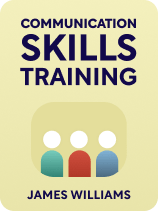

This article is an excerpt from the Shortform book guide to "Communication Skills Training" by James Williams. Shortform has the world's best summaries and analyses of books you should be reading.
Like this article? Sign up for a free trial here.
Do you have a reputation as a good listener? Does it feel like you have to repeat yourself a lot? Do you get easily triggered, or do you seem to set other people off emotionally?
Communicating effectively with others is a crucial skill—it’s how we build and maintain relationships, solve problems, and accomplish tasks. However, James Williams explains that good communication skills don’t come naturally—instead, they’re built up over time through intentional practice.
Keep reading to learn about four core communication skills and how to practice them in your everyday life.
4 Core Communication Skills
In Communication Skills Training, Williams outlines the core abilities of effective communication and provides practical tips on how to develop them so you can express yourself well, build your charisma, and win people over. Let’s take a look at each core communication skill.
Skill #1: Active Listening
Williams explains that to communicate effectively, you must fully understand the other person—not just the content of their statement, but the emotions and intent behind it. To form this understanding, you must actively listen. Pay attention not just to what they say, but how they say it—their tone, word choice, body language, and so on. If you don’t, you may misunderstand the other person—or miss their main point—and therefore respond inappropriately.
For example, your friend might be telling you about their son’s soccer game and an encounter they had with a mean person there. Their eyebrows knit and their tone sounds dejected—their intent was to express their hurt feelings from the encounter. However, you respond by asking who won the soccer game because you weren’t paying attention to the smaller details that indicated which part of the person’s story was most important.
Williams provides four main tips for practicing active listening.
Tip #1: Prepare to Receive the Other Person’s Message
To prepare to receive the other person’s message, Williams makes three main recommendations. First, make eye contact. Second, fully concentrate on the other person. Third, keep an open mind so you can receive their message without making judgments.
Tip #2: Receive Their Message
To effectively receive someone’s message, Williams says you must continue to focus entirely on the other person. Listen to what they say and don’t say, and try to pick up on their emotions by paying attention to their tone, facial expressions, body movements, and so on. Avoid thinking about your response to their message or making judgments on what they’ve said—you can’t listen and reflect at the same time. Further, show the other person you’re listening by nodding along or giving vocal affirmations like “mhm.”
Tip #3: Prepare to Respond
Williams says to make sure the other person is completely finished speaking before you formulate your response. Plan to match your emotions to theirs—this will help you respond appropriately. For instance, if they seem sad and muted, avoid being inappropriately exuberant and joyful. Further, make sure you respond to the main point they’re making rather than the unimportant details.
Tip #4: Respond Effectively
When you respond, Williams recommends showing the other person you understand them by sharing your interpretation of what they said, explained in your own words. Further, avoid responses that might indicate you’re uninterested in listening to them or want to make things about yourself—for instance, offering advice, pity, corrections, comfort, or personal stories, or trying to one-up them.
Skill #2: Establishing Connection
Next, Williams explains that effective communicators must establish connections with others. This is because as factors in your life change, such as your job or where you live, you’ll be forced to meet new people and build new relationships.
Williams offers four main tips for building new connections:
Tip #1: Mind Your Confidence
Williams explains that it’s important to enter conversations with confidence and high self-esteem. When you’re confident, other people will see you as credible, which leads to a more effective conversation. Williams notes you can express confidence through your non-verbal communication—your tone, body language, expressions, and so on. Specifically, sit up straight with your shoulders back and your chin high. Further, monitor your tone—being too quiet can make you seem timid.
Tip# 2: Be Authentic
Despite monitoring your words, tone, and body language, Williams warns not to censor yourself too much. Be your authentic self—people are attracted to authenticity. For example, if you’re a jokester, use humor, and if you’re into more philosophical topics, discuss them.
Tip #3: Find Common Ground
Williams explains that finding common ground—shared interests, dislikes, experiences, and so on—is one of the best ways to establish a connection with someone. It’ll also help you further your connection by giving you natural conversation topics.
However, Williams warns against asking the other person specific personal questions too soon—this can make people defensive, especially when you’re first getting to know them. Instead, be more general: Ask them to tell you more about themselves so they can offer up whatever information they feel comfortable disclosing.
Tip #4: Pay Attention to Personality
Williams recommends figuring out the person’s personality type and tailoring your communication to match their type’s preferred communication style. For instance, if your conversation partner is impatient and focused on getting to the point, be direct with them and avoid mentioning any unnecessary details that they may see as a waste of time.
Skill #3: Emotional Control
Williams explains that emotional control is central to effective communication because, when we’re unable to control strong emotions, we tend to express ourselves poorly—for example, by yelling, making accusations, or failing to clearly explain our message. When we express ourselves in such ways, the other person will likely struggle to understand us, and they may even become offended and shut us out.
Here are four tips for controlling your own strong emotions and avoiding triggering them in others:
Tip #1: Manage Your Emotional Triggers
Williams advises learning what types of situations and pet peeves trigger your strong emotions. That way, you can prepare for these situations in advance and catch yourself before you react emotionally. For example, when you anticipate a trigger, close your eyes and imagine petting your dog to calm yourself down.
Tip #2: Overcome Negative Assumptions
Often, we react emotionally due to negative assumptions we make about others and their intentions. For example, if someone’s tone seems demeaning to you, you might get angry and accuse them of patronizing you. To avoid this, Williams recommends replacing negative assumptions with positive ones. For instance, instead of patronizing you, maybe this person is trying to be gentle so they don’t hurt your feelings.
If you can’t convince yourself of positive intent, avoid resentment by simply accepting that everyone is different and has their own flaws and characteristics—you can’t control people, so accept them for who they are.
Tip #3: Write Out Your Thoughts
When you feel strong emotions like anger or stress, Williams says to write down your thoughts and feelings to release them. This will also help you determine how rational your emotional reactions are—writing helps you organize your thoughts so you can make a more accurate judgment on whether or not your feelings are reasonable.
Tip #4: Be Respectful
When talking about your emotions, Williams recommends using “I feel” statements to express yourself—for example, “I feel hurt about what happened” or “I feel anxious about this situation.” This will help you avoid making unfair accusations, even when you’re angry or believe the other person’s at fault because you’re focusing on describing your emotions rather than the other person’s actions.
Further, focus on the issue at hand—don’t bring up unrelated past issues that you’re harboring negative emotions about. This could upset the other person and ignite negative emotions for you as well.
Skill #4: Accuracy and Clarity
Williams explains that expressing yourself accurately and clearly is crucial. If you don’t, the other person will likely misunderstand you, and you’ll fail to achieve your goal for the conversation. He offers the following tips for staying accurate and clear:
Tip #1: Communicate About Important Topics Face-to-Face
Williams suggests holding important conversations face-to-face, not via text messaging, noting that misunderstandings are much more common in written communication like texts or emails. This is because you’re not able to pick up on nonverbal elements like tone, body language, and facial expressions, which are important to understanding the other person’s feelings and intent.
Tip #2: Be Concise and Direct
Williams recommends using as few words as possible whenever you communicate—the fewer words you use, the less room there is for misinterpretation. Further, directly state what you want or need to make it easier for the other person to understand your message.
Tip #3: Check For Understanding
Rather than assuming you and the other person understand each other, Williams says you must regularly check in by summarizing what’s happened in the discussion so far and ensuring the other person is on the same page.

———End of Preview———
Like what you just read? Read the rest of the world's best book summary and analysis of James Williams's "Communication Skills Training" at Shortform.
Here's what you'll find in our full Communication Skills Training summary:
- Why effective communication is one of the most important skills to have
- How to develop your communication skills through intentional practice
- Why emotional control is central to expressing yourself effectively






